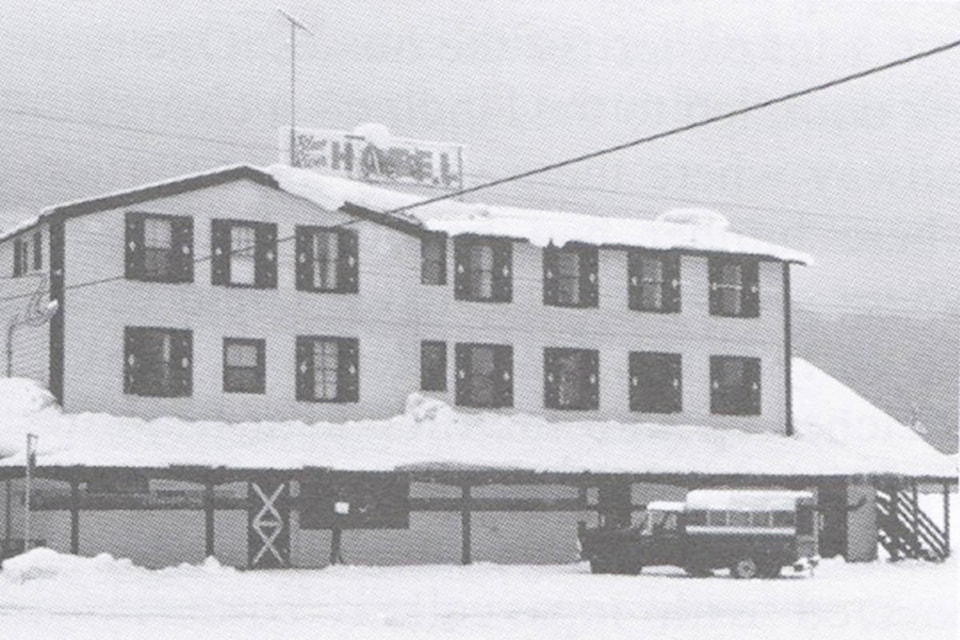The following is an excerpt taken from Upper North Thompson Reflections
Compiled by Lois Moss
Blue River, an important divisional point of the Canadian National Railway, is situated about halfway between Kamloops and Jasper. A wide valley near the confluence of the North Thompson River and one of its largest tributaries, the Blue River, holds the community in a beautiful mountain setting.
This section of the North Thompson was explored by Lord Milton and Dr. Cheadle prior to 1870. I t was only a few miles from Blue River that Milton and Cheadle discovered the “Headless Indian” - an intriguing mystery. It is said that a CPR survey party discovered more artifacts and left this inscription at the site: “Here lies the remains of the headless Indian discovered by Lord Milton and Dr. Cheadle, A.D. 1963. At this spot, we found an old tin kettle, a spoon and fishing line, and 150 yards up the riverbank we also found the skull which was sought for in vain by the above gentlemen. June 5, 1872. ‘T’ Party C.P.R.S.”
The earliest settler in the Blue River area was A. D. Cook followed by John Daline, ‘Blue River’ Smith, D. Crowley, R. Wilkins and John and Charles Lawson, in about that order. Several members of the government survey in 1912 took preemptions within a radius of three miles from the present townsite.
G.L. Stewart, who preempted land near Thunder River in 1913, was soon joined by his wife, who lived in Blue River for several months, and was probably the first white woman to settle there. From the day of her arrival, her cabin was the centre of cheer and hospitality for the lonely homesteaders around.
At an elevation of 2237 feet, the fresh, fine tangy air is thought to be responsible for the good health and well-being of its residents. The quality of the Blue River water is a factor in this as well.
In the late 1950s, Mrs. L. Harrison described Blue River this way: “The permanent population of Blue River averages about 325, at present almost trebled by workers on the Trans-Mountain Oil Pipeline and their families. The presence of these new residents has contributed greatly to local activities and prosperity. A pleasant association with those from the United States has created an improved understanding of our neighbours to the south.”
Blue River is the centre of a large area of fine timber — fir, spruce, white pine and cedar. Our hills provide excellent hunting and fishing and Murtle Lake, in Wells Gray Park, is only 17 miles from Blue River — accessible by plane and hiking trails. In winter, good skiing is available to all keen enough to climb – from October to June, the skiing opportunities challenge the amateur and the professional.
Warm springs make Eleanor Lake, a few minutes’ walk from the depot, a delightful and popular place to swim from spring to fall. Some residents enjoy and share their speed boats on this lake, and on much larger Mud Lake, reached via the Thompson and Mud Rivers.
One aspect of the Blue River cannot be exaggerated — namely its beauty. Mrs. Harrison wrote, “After more than thirty years as a resident, and after much comparison with other parts of the world, the natural surroundings are still breathtakingly lovely to me. Fitting smoothly into the blending variety of North Thompson scenery, Blue River’s wide valley affords appealing perspective — the dark peaks, their numerous glaciers one never tires of viewing — and beyond, the start grandeur of more rugged terrain.
Our mountains look friendly, never overpowering, and people who have lived here tend to return, as do visitors. Our recent guest from Texas wrote, ‘I never so much hated leaving any place.’”
